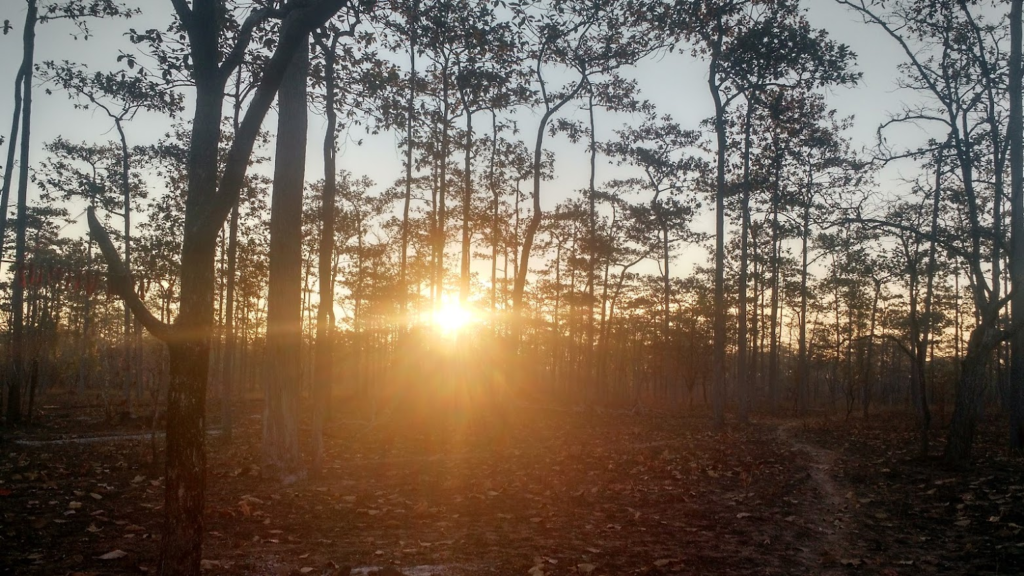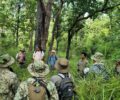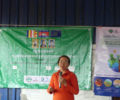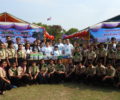Can REDD+ Re-Energise Communities Commitments to Protect their Forests?
If you travel to Lomphat Wildlife Sanctuary along National Road 76 from the west, the boundary is easily recognised as it is demarcated by the Srepok River, at the point where the road crosses the river over a large and relatively recently-built concrete bridge. Upon alighting on the eastern bank you have now arrived in the Commune of Sre Angkrong in Koan Mom District in Ratanakiri Province. On either side of the road stands an almost dictionary-definition perfect example of the sanctuary’s dominant habitat type, Dry Deciduous Forest, sometimes called Dry Dipterocarp Forest or DDF. The forest here is quite open, with well-spaced trees with sparse crowns that let ample sunlight through to almost meadow-like grassland terrain on the forest floor. As the road continues east, if you head south a few kilometres there you will find the villages of Sre Angkrong lying along the banks of the Srepok River.
It is, however, also evident to even a brief observation from the road that this area has experienced fairly dramatic land conversion, and the view from the road actually conceals the magnitude of it. Cross the river from Sre Angkrong and you will immediately be trespassing in the largest contiguous monoculture plantation in Lomphat Wildlife Sanctuary. The plantation was created as an Economic Land Concession, a type of licensed agricultural development, and the like of which have reduced the forest cover in Lomphat over the last 20 years by over a quarter of its total area.

For the villagers of Sre Angkrong, the current and future generations now have far less forest and natural resources available for them to depend on than their parents or generations before them.
Mrs Vaet Phumi, is the First Assistant of the Sre Angkrong Commune Council. Mother of five daughters and a son, her and her husband have lived in Phum Bei, in Sre Angkrong commune their whole lives. In 2012 she joined the Sre Angkrong Commune Council to help her community improve their area. Despite a modest salary, and the challenges of being a woman in a male-oriented decision-making culture, she enjoys the work, and has assumed a leading and active role. Recognising the need to provide a framework to manage their natural resources responsibly, she was involved in the setting up of an official endorsement of the areas own Community Protected Area, called O’Koki CPA.

O’Koki is an active and functioning CPA, and has helped to protect the forest and the non-timber forest products that the biodiversity provides. In recent years though, the reality of the one-directional headwind towards forest conversion or degradation have taken their toll on the CPAs spirit of will. The low-paid jobs on the plantations attract people from surrounding areas and provinces, and the shrinking natural habitat around intensifies the unsustainable practices, chiefly illegal fishing, illegal poaching, and illegal logging, on the remaining forest. Referring to voluntary members of the CPA who patrol, manage, and monitor their forest, Mrs Phumi has seen an understandable decrease in commitment. “They feel reluctant because they have less benefit” she says, “they have to spend a lot
of time, energy, and personal money to protect the community forest. Now we have less people protecting the community forest, but more pressure from people to access our community resources. This cannot go on forever before the natural resources are gone.”
But there is still forest standing, a legal framework in the CPA to protect it, and people like Mrs Phumi have not given up. After joining the exchange visit organised by NatureLife Cambodia to visit the REDD+ Project in Keo Seima Wildlife Sanctuary (Mondulkiri Province, Cambodia) in January 2023, she saw the real and tangible positives of REDD+ projects in areas with similar challenges. Witnessing how the indigenous communities there had unified and devoted their time to protecting the forest, and in return were using their share of the financial benefits generated through the sale of the carbon credits that the REDD+ model provides, she fosters some hope that this can be replicated in Sre Angkrong.
NatureLife Cambodia (NLC) is a Cambodian conservation organisation with a mission to conserve biodiversity by managing natural resources sustainably for the benefits of local communities and biodiversity. In close collaboration with the Ministry of Environment (MoE) and NGO partners, NLC has supported and led conservation activities in Lomphat Wildlife Sanctuary (LWS) since 2004, focusing mainly on capacity development for law enforcement, monitoring and conservation of endangered species, and facilitating the participation of local communities in sustainable forest management, including supporting CPAs such as O’Koki. In 2022 NatureLife launched its project to implement REDD+ in LWS.
Envisioning a situation where schemes such as REDD+ can be used to prevent the conversion of community forest to privately managed plantations, Mrs Phumi says she believes that “if we come together as a community to protect our natural resources, then our children and their children will also be able to have timber for their housing and they have a chance to know about our luxury wood. So, we must focus our attention to protect these resources for all of our benefit.”
Shortly, communities around the LWS REDD+ Project area will decide whether they wish to engage with and provide consent for the REDD+ project in their local areas, but in Sre Angkrong, it seems there is already strong local support. Establishing links and support between the communities and local authorities will continue to be important in the long journey to protect the forest and biodiversity.
Tagged:



